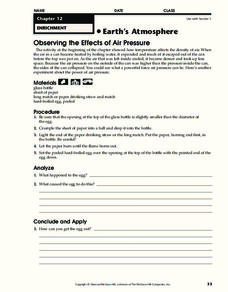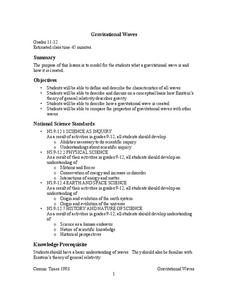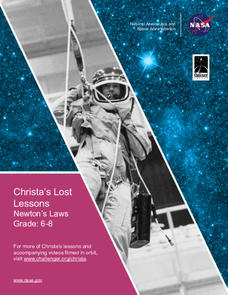Curated OER
The Incredible Light Bulb-Egg Drop Challenge
Students examine how spacecraft land on Mars. Using eggs or lightbulbs, they design a craft that withstand a drop from a table or ladder, competing in groups to see which module demonstrates the most successful landing.
Curated OER
Pendulum Activity
Fourth graders conduct a lab activity that measures the factors that change the swing rate of a pendulum. They create a hypothesis and test it during the experiment. They record their observations using the recording sheets and journal...
Curated OER
Newton and his Laws
Students explore Newton's laws, including what they state, and what the intuitive meaning is of the first and third laws.
Curated OER
Types of Weathering Vocabulary
For this weathering worksheet, students are given vocabulary terms and definitions related to weathering. They match the proper term with its definition.
Curated OER
Tightrope Trials
Students research the concepts of center of mass and how to make different things balance. They make symmetrical cut-outs of different "creatures" and experiment with how they balance on a tightrope of string.
Curated OER
The Solar System
Students describe the different bodies that make up our solar system, explain the place of our solar system within the Milky Way Galaxy and the universe, explain day and night and the Earth's movement, and describe the relationship...
Curated OER
Metric System Challenge
In this measurement activity, students complete each of the statements with the correct word related to the metric system. Then they match each letter marked with a number to those at the bottom of the sheet to complete the answer to the...
Curated OER
Plasmasphere
In this plasmasphere worksheet, students determine how long the plasmasphere takes to rotate around the Earth using two satellite images taken three hours apart.
Curated OER
Worksheet 4
In this math worksheet, students define the details of a definite integral and how it is used. They also apply math to physics to compute how work for lift is calculated.
Curated OER
Parachutes
Students control the parachutes using arm movements. They follow directions while participating in games. Students explore the effects of wind on several objects. They study the effects of shape, size and weight on a parachute.
Curated OER
Environment: Erosion Boxes
Fourth graders discover how the processes of erosion and weathering alter the physical characteristics of the environment. In a student log,they record the various types of erosion and list ways to prevent it. Using clear, plastic...
Curated OER
Earth's Atmosphere
In this Earth's atmosphere learning exercise, students observe the effects of air pressure using an egg. They describe what happens to the egg and what makes it do what it does. Then they determine how to get the egg out of the bottle...
Curated OER
Space Weight, Gravity, and Distance
In this planets in space worksheet, learners calculate their weight on the 9 planets plus calculate the distance of the planets from the sun in astronomical units. This worksheet has 6 fill in the blank and 3 short answer questions.
Alabama Learning Exchange
Investigating Friction
Young learners explore friction. They view a video or DVD (bibliography provided) and define terms related to friction, and work in groups to experiment with the effects of friction on speed and motion using ramps and toy cars.
Urbana School District
Gravitation
Introduction your class to famous astronomers with a presentation that also covers Newton's Laws of Gravitation, Kepler's Laws of Planetary Motion, both uniform and nonuniform gravitational fields, and how to calculate the gravitational...
Teach Engineering
Adapatations for Bird Flight - Inspiration for Aeronautical Engineering
It's a bird, it's a ... device made to mimic birds. The eighth installment of a nine-part module has pupils read various articles to learn about bird flight. They consider the implications for aeronautical engineering.
DiscoverE
Pilot a Balloon
Balloons will go where you want them to. Young pilots first add paper clips to a balloon to make it neutrally buoyant. They then use cardboard to steer the balloon in different directions, taking air pressure into account.
K12 Reader
Why Does the Moon Orbit Earth?
Have you ever looked up at the moon and wondered why it looks different every night? Learn about the moon's orbit and the lunar cycle with a reading comprehension exercise. Using context clues, kids find the definitions of unfamiliar...
LABScI
Viscosity: The Fluid Lab
There's more to fluids than meet the eye—they include gases, liquids, and polymers, too! Scholars complete three hands-on activities exploring different properties of fluids. They explore viscosity by measuring the resistance, or...
Teach Engineering
Magical Motion
Make solutions to projectile motion problems magically appear using equations. Pupils watch a clip from a Harry Potter movie and find the length of time it takes for a remembrall to fall into Harry's hands. They use a projectile motion...
NASA
Gravitational Waves
Young scientists participate in a hands-on experiment to explore Einstein's theory of relativity in a creative manner. They investigate various waves and compare their characteristics as they discuss how each wave is created....
Flipping Physics
AP Physics 1: Universal Gravitation Review
Everything scholars will need to know about universal gravitation in order to be prepared for the AP Physics exam. is provided in this fast-paced video. Test taking tips and common misconceptions are also addressed in the film.
Colorado State University
Why Do Raindrops Sometimes Land Gently and Sometimes with a Splat?
A mouse can fall from large heights without injury! Air resistance is a large influence on small falling objects. In an exploratory lesson, young scholars build a raindrop bottle to compare the falling rate of different-sized objects.
NASA
Christa's Lost Lesson: Newton’s Laws
How do the laws of motion work in space? Learners explore Newton's laws of motion in different experiments as part of the Christa's Lost Lessons series. They rotate around the room in three stations to experience each law in action using...























